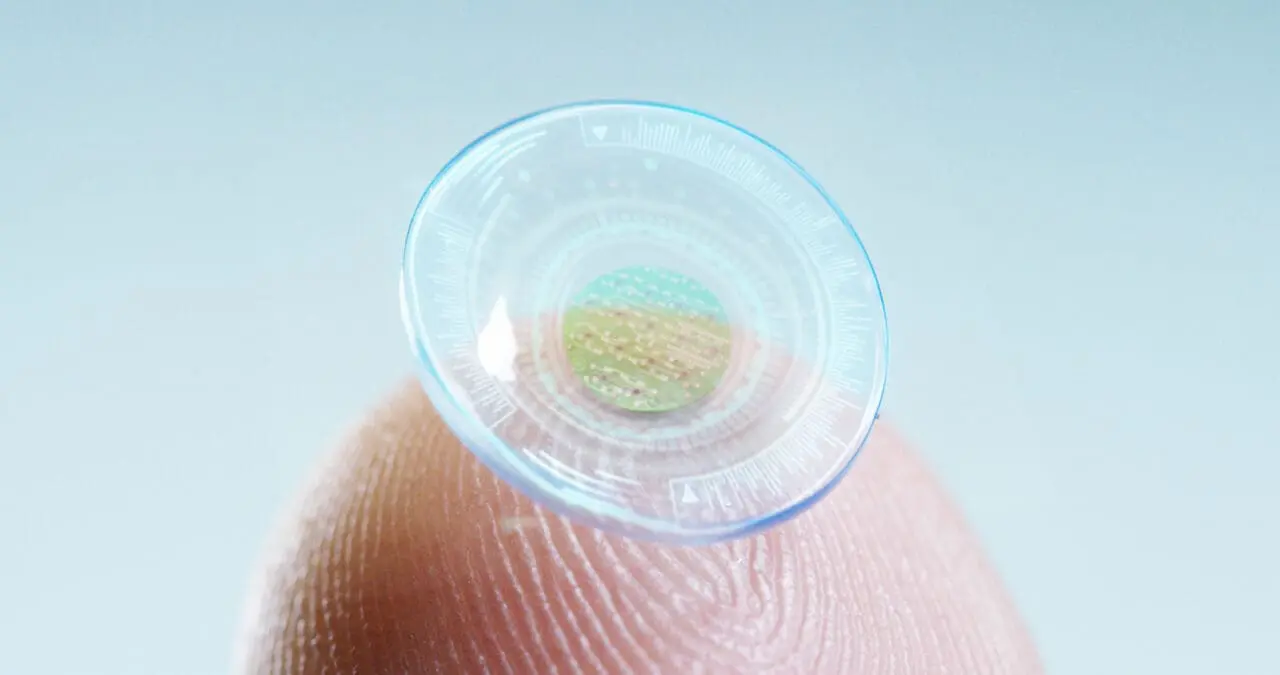

This insight looks at the development, applications, and issues relating to new ‘smart eye’ wearables such as smart glasses and contact lenses.
Smart contact lenses, such as those in development by health and technology company Mojo, use a tiny micro-LED display the size of a grain of sand to display information to the wearer (augmented reality). The lenses, which are still in development, also include smart sensors powered by solid-state batteries built into a scleral lens that can correct the wearer’s vision.
The company notes that there is now a broad acceptance of wearable technology, but other wearables have limitations, e.g. for those engaged in sports and workouts. For example, Mojo’s research found that 68 per cent of respondents find it often difficult to check a device during their workout. Therefore, Mojo’s smart contact lenses may have an advantage over smart watches and fitness bands because users don’t have to interrupt their activity to check them, plus they can provide better access to data during performance. Although Mojo’s current focus appears to be using the lenses for sport, they could have many other applications.
Other companies are also developing their versions of smart contact lenses. For example, as far back as 2016, Samsung patented smart lenses with built-in cameras capable of recording video and taking pictures. Sony is also known to have been experimenting with smart contact lenses for many years.
UK company Specsavers notes that smart contact lenses could help manage the five most common eye conditions in the future: cataracts, glaucoma, diabetic retinopathy, macular degeneration, and retinal detachment. For example, the company says that smart contact lenses already offer a non-invasive way to monitor glucose and capture spontaneous changes in the eyes to help doctors treat glaucoma.
There have been many developments in the smart glasses market in recent years.
Google ‘Glass’ is the tech giant’s smart glasses product. The ‘Glass’ that smart glasses incorporates cameras and provides the wearer with AR displays and information in their peripheral vision area. The Enterprise Edition glasses can be used in a wide variety of industries to give workers hands-free access to information while working and enable them to share what they are seeing (via the camera). This can enable triaging and getting help and advice (real-time collaboration), leading to faster problem solving and improved productivity. The ‘Glass’ smart glasses have been used in healthcare, warehouse order picking, supply chain management and logistics. Google’s ‘Meet on Glass’ also allows meeting participants to experience a first-person view of the Glass wearer’s perspective and collaborate with the video meeting in real-time.
American company Vuzix has developed smart AR binocular glasses to enable business owners, operators, and workers access to ‘the metaverse’. Vuzix’s hands-free and voice-activated glasses (which also incorporate HD stereo cameras) can be used to access AR tools in healthcare (surgeons while operating), warehousing (helping with stocking, order picking and real-time decision-making support), field service, and other industries. The company also says that its glasses can link up with collaborative working and communications platforms. Back in 2019, Vuzix also developed smart glasses that incorporated facial recognition algorithms from Dubai-based company NNTC that could be used by security and law enforcement for covert surveillance.
Meta / Facebook Ray-Ban ‘Stories’ smart sunglasses incorporate dual integrated 5MP cameras enabling the wearer to take photos and up to 30-second videos using a capture button or hands-free voice commands. Meta says that the glasses also allow the wearer to share their “adventures” and listen to music or take phone calls.
There are, however, several challenges to the expansion and further development of wearables like smart contact lenses and glasses. These challenges include:
– Compliance with privacy laws such as GDPR. Glasses that take pictures and videos of people without their consent and how those pictures and videos are stored and shared are a matter of privacy regulations.
The nanotechnology involved in smart contact lenses and how to link the different technologies together successfully is a significant challenge, which is one of the reasons these types of smart wearables have taken years to develop.
– Getting approval for the use of smart optics in certain settings, such as in healthcare, is something that may take time in different countries.
– Marketing what are essentially new, high-price technical products such as smart glasses is a challenge in itself.
The use of smart optics in many different industries has already proven itself to improve effectiveness and productivity and allow better real-time problem-solving and communication, all of which can add value and improve competitiveness for businesses. For example, smart contact lenses are an interesting and exciting development in hands-free AR assistance for workers, athletes, and even as a way to monitor eye health and help catch potentially serious eye conditions early on. Also, the fact that they are not outwardly visible (like glasses) may make them particularly well-suited to professions where surveillance is required. There are, however, challenges, both technical and legal (privacy), to overcome before the further development and wider use of these types of wearables can start to enter the mainstream, with greater regulation expected along the way.
This website uses cookies to improve your experience. Choose what you're happy with.
Required for the site to function and can't be switched off.
Help us improve the website. Turn on if you agree.
Used for ads and personalisation. Turn on if you agree.
This website uses cookies to improve your experience. Choose what you're happy with.
Required for the site to function and can't be switched off.
Help us improve the website. Turn on if you agree.
Used for ads and personalisation. Turn on if you agree.